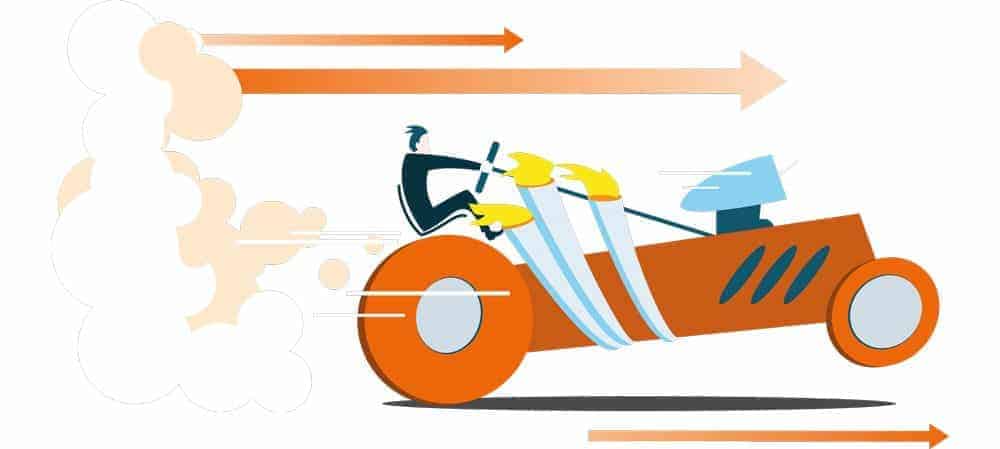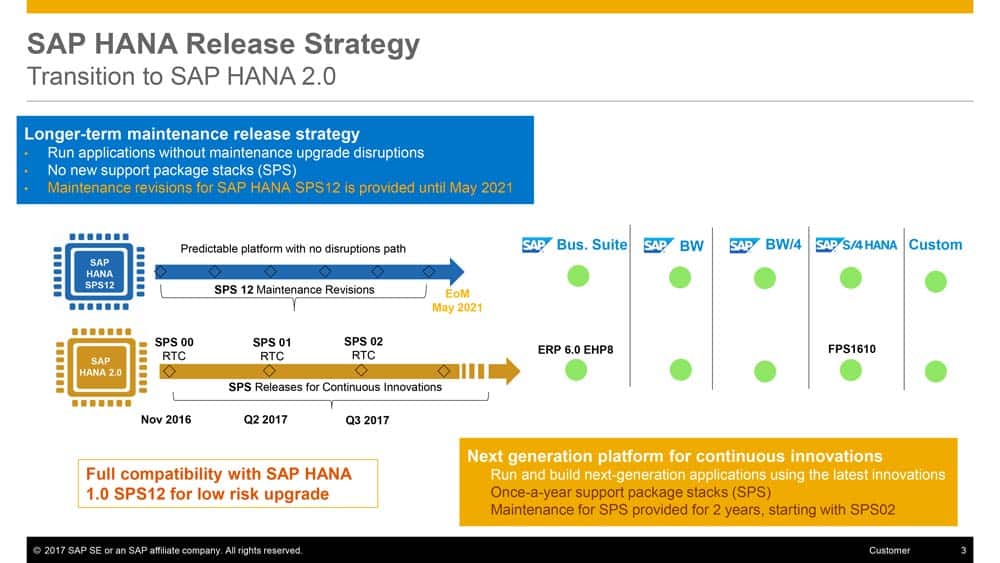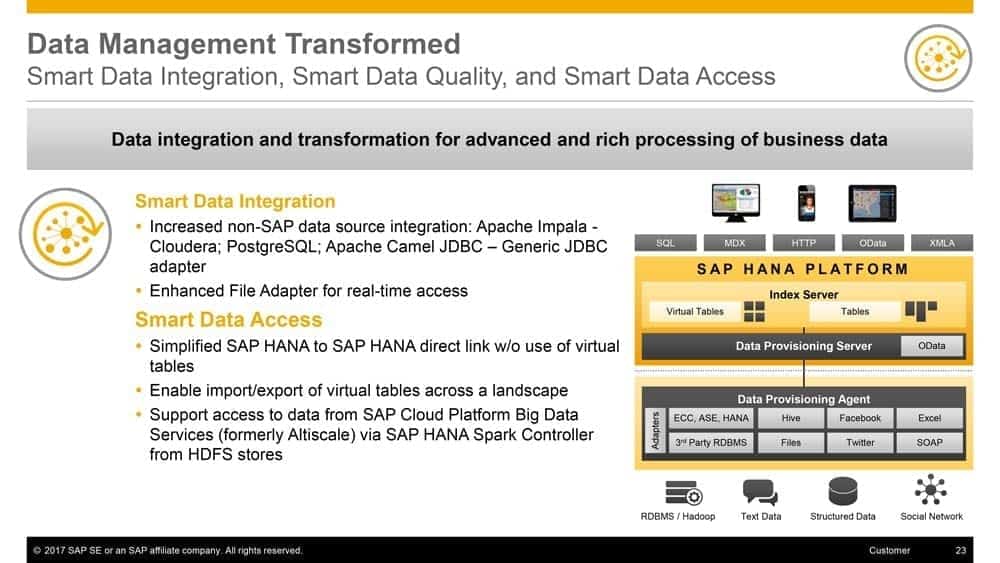In catch-up mode


From IBM, "With HoP, we're addressing not only previous SAP customers using IBM Power systems, but also x86 customers who are dissatisfied or expected something different."
And indeed, the degree of satisfaction among one or the other SAP customer with the Hana in-memory Intel hardware used seems - to put it cautiously - to be limited. One HoI user, for example, reports that (BW-on-Hana) reports created for a small user group (three or four users) require an additional core expansion, with the corresponding additional costs - even though one of the largest available Hana-on-Intel systems is in use. There were also unforeseen system instabilities with Suite on Hana (SoH). SoH is used by around 12,000 SAP users worldwide.
As a kind of technology overseer, SAP is certainly aware of possible areas for optimization in the use of Hana on Intel systems. After all, SAP provides the specifications for the Hana on Intel servers or releases further developments - and probably also receives feedback from HoI providers or from SAP service providers. For example, with regard to stability in various application scenarios, core-to-memory ratios or the use of virtualization technologies. But one might ask the question: Why doesn't SAP also rely here on open source, such as Xen or KVM, instead of exclusively on VMware/vSphere? As far as Hana servers based on Power8 processors are concerned, IBM was only able to start the market entry with a delay, as is well known, whereby it was apparently not due to the SAP partner IBM. Now, however, IBM is obviously feeling the tailwind for the Hana on Power systems (scaleup and scaleout systems), which were already certified by SAP some time ago. The company is in catch-up mode, so to speak. This is also because IBM has apparently been able to gain sufficient experience in Hana operation with various SAP users. According to the company, it currently has about 850 customers worldwide who have purchased Power Systems for use with Hana, all together with Suse Linux Enterprise Server (SLES) for SAP Applications as the operating system platform. And it expects to pass the 1,000 mark as early as the current third quarter. 
Now reportedly 5,800 S/4 customers
According to the company, "the majority of the HoP systems are distributed across Suite on Hana as well as BW on Hana and around ten to 15 percent on S/4 Hana". There is currently no concrete information on what percentage of the systems are already running productively. The latest figure for the business suite technology successor S/4 is said to be around 5,800 licenses sold. Of these, certainly not all have been put into production. By the way, the next S/4 release is 1709. 17 stands for 2017 and 09 for September. The fact that partnering between IBM and SAP has increased in terms of Hana on Power can be seen, for example, in the recently intensified sales and marketing activities. Customer events under the motto "The perfect match: Hana and IBM Power" - with SAP participation - are being held. In addition, banner ads on the subject of "IBM and SAP" are being used for advertising purposes. This would probably not be possible without SAP's approval.
Well-considered differentiation
What are the main advantages of HoP compared to the HoI competition? how do you position yourself in the Hana server market? or what is the main difference between IBM's Hana hardware offering and the Hana on Intel competition?
It can't be the purchase price compared to the HoI systems. IBM communicates that a bit more money has to be spent when buying HoP systems compared to HoI systems. Nevertheless one gets "quality for it. And the somewhat higher acquisition costs are recouped through the flexibility advantages gained," according to the argumentation. According to the company, these are based in particular on the possibility of being able to flexibly switch on or off existing and underutilized processor resources (resources within so-called LPARs with logical partitioning of the IBM PowerVM virtualization technology) or memory resources, as well as move/assign them, even in the context of a private cloud IaaS environment, for example.
With PowerVM, it is possible to create LPARs in a bandwidth of, for example, 0.1 cores with an in-memory size of 32 terabytes, or, conversely, to define only the LPAR with 1 GB and 192 cores, independently of processor sockets and the main memory installed in them, to flexibly provide or use resources for Hana, depending on the use case. Further system consolidations can also be implemented with this. This is not possible in the Hana on Intel environment, it is emphasized. In addition, the usable number under PowerVM is 7 productive LPARs with Hana on the large IBM Power Enterprise Servers, non-productive Hana workload and all other applications such as SAP application servers, AIX, Linux, System i etc. are operated in the shared processor pool. The PowerVM overhead is also much lower than with VMware and x86.
The second benefit IBM highlights relates to the RAS aspect; everything to do with reliability, availability and serviceability. "We have been familiar with IBM SAP systems and SAP landscapes for decades, down to the last detail, and we know how smooth and efficient 7×24 SAP mission-critical operations work, for example with S/4 Hana or Suite on Hana, as well as which requirements and necessities are necessary for this, implementable with Power and other IBM solutions," says the ondit. According to the company, it covers the important topics in the SAP environment such as high availability (HA) and disaster recovery (DR), also with the Hana System Replication Service or the Suse SLES for SAP Applications High Availability Extensions (HAE), as well as with its own solution offerings - depending on the user requirements and what the user is willing to pay for a Hana HA or DR solution.
Last, but not least, IBM points out the performance that could be achieved with Hana on Power hardware. Here, for example, it is argued that there are advantages to be gained from strong cores with high bandwidth. Thus, one could process up to eight threads per core; Intel only two. The concept of strong cores with high bandwidth is ideal for Hana in-memory applications, they want to know. HoP application examples are cited as evidence, such as from a pharmaceutical company that used 50 HoP cores (BW on Hana, seven TB Hana memory, scale-up system) instead of 300 HoI cores, and response times were reduced by 14 percent. Similarly, a Bank Analyzer deployment is reported where the throughput of Hana on POWER was a factor of 4 higher than under Hana on Intel. IBM also emphasizes a so-called "smart error correction", a kind of hardware self-healing functionality for the main memory, which should ultimately contribute to fewer Hana failures. Without this feature, a Hana database with one TB would not be available 32 times per year or could not be used extensively due to a failure, according to the explanations, statistically considered.
Heterogeneous customer base
IBM provides various HoP scaleout servers based on Power8 (9, 10 and 11 are on the Power roadmap and are already in development) with 512 GB in-memory capacity up to enterprise servers with a maximum of 32 TB main memory. Of course, SAP's TDI (Tailored Datacenter Integration) concept is supported, with the option of using HoP servers and infrastructure components such as storage or network components from another supplier. However, the company does not hide the fact that "we prefer SAP customers to use Hana on Power systems together with IBM Spectrum storage products, including FlashSystem and Storwize. If you take the trouble to look at which SAP customers (groups) are among the 850 HoP customers to date, you will see that they are not exclusively former SAP Power AIX customers (SAP Classic). But also former Hana on Intel customers. HoP customers are often very large SAP users, but also SMEs, as well as SAP service providers. In addition, they are existing SAP customers who have switched from their "AnyDB" to Hana or are in the process of doing so. Interestingly, also from IBM DB2 to Hana. One would love to be a fly on the wall in the internal discussions between the "DB2 and Hana on Power factions"...
Study Memories
The eye wanders somewhat perplexed over a pie chart showing the market shares of Hana server suppliers in an IDC study from November 2016. In the Gartner study, HPE (for physical deployments) is clearly in the lead, with well over 50 percent, followed by Lenovo, Fujitsu, Dell, Cisco, Hitachi, SGI, Huawei, IBM, Atos, and NEC. Looking at the IDC pie chart, however, Cisco is listed as number one with just over 20 percent, then comes HPE (16.4), followed by IBM Power (15.3), Dell (15), Lenovo (6.9)/IBM System x (8.9), Huawei (4.2), Bull (Atos 4.0), Fujitsu (3.1) and others with 5.8 percent. A second look reveals that only the North American market was considered in this IDC study, based on 300 responses. The differences could be due to the different periods of observation or the restricted geographic survey. However, the differences are always strange or striking.






